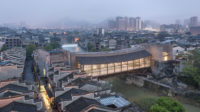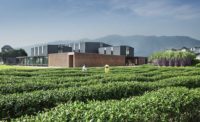Bridging the Urban-Rural Divide














Every year about a million people in China move from rural villages and towns to big cities. Lots of planning efforts—both good and bad—have focused on fast-growing cities, but very little work has looked at the countryside where depopulation and the changing economics of farming threaten the very existence of many villages. With that as a backdrop, the University of Southern California’s American Academy in China (AAC) and its School of Architecture addressed the urban-rural divide in an exhibition and symposium in the southern Chinese city of Shenzhen near the end of July.
Entitled China in Flux: Mapping the Middle Zone, the events brought together students and teachers from universities in Asia, the United States, and Europe, as well as speakers from academia, business, and the media. (Disclosure: this writer made a presentation and moderated a panel discussion.) The goal was to apply innovative thinking to the challenge of shrinking and disappearing villages. Can planners, designers, and developers find ways of reviving rural areas without destroying the characteristics that make these places attractive—such as traditional ways and scenic landscapes?
At the symposium, Qingyun Ma, dean of USC’s school of architecture, talked about a program he calls C.A.N.: Culture, Agriculture, and Nature. “We need to devise a form of agri-urbanism,” said Ma, “one that applies radical solutions to the particular problems of the countryside.” Ma has been exploring such issues in his father’s home village, Lantian, outside the city of Xi’an in central China where he is developing a winery and resort called Jade Valley. A set of buildings designed by Ma during the past decade provide space for wine production, entertaining, and tourism, and he is currently working with other architects to add villas and cultural facilities to the complex in the foothills of the Qinling mountains. The architecture combines modern and vernacular principles to create a 21st-century interpretation of traditional building forms. “Jade Valley may not be easily replicable in other parts of China,” said Ma, but it demonstrates one way of revitalizing a small rural village.
To leverage new ideas on a broader scale requires a different kind of operation. “You need to combine the artistic with the business model,” stated Ma. To do that, USC teamed up with AVIC Legend, a large Chinese construction and design company that is considering a project in Lushan, a mountainous part of Jiangxi Province. AAC students spent a few weeks in Lushan developing ways to renovate and adapt a group of traditional buildings for new purposes such as tourism and culture. The students speculated on new uses for the buildings and proposed “architectural and branding strategies,” said Gary Paige, the AAC director. “Lushan is an iconic place, both culturally and historically,” stated Nan Xiao, chairman of AVIC Legend. Buddhist and Taoist poets and monks made the area famous, starting centuries ago. Stressing the importance of retaining the character of Lushan, Nan explained, “Not all damage is physical. Sometimes it can be done by just changing the way we experience a place.”
The exhibition in Shenzhen, which Paige curated, presented work done by students and professors at 13 universities, including USC, Harvard, MIT, Columbia, the Central Academy of Fine Arts in Beijing, Chinese University of Hong Kong, the Architectural Association, ETH Zurich, and La Salle University in Barcelona. It also showed projects by practices such as Rural Urban Framework and davidclovers in Hong Kong, as well as Robert Mangurian and Mary-Ann Ray’s firm B.A.S.E. Beijing.
“The binary relationship between cities and villages is changing and in flux,” said Paige, “resulting in a condition that is characterized by blurred zones and ambiguous territories.” The work displayed at the exhibition aimed to find ways of defining those places of “in-betweenness” and giving them identities that acknowledge the past while preparing for the future, said Paige.












